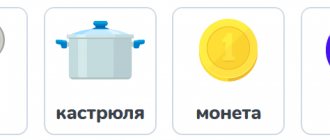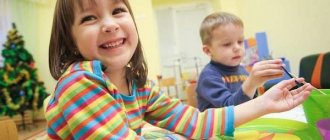What is a child's self-esteem
A child’s self-esteem is the preschooler’s perception of his qualities, his character and personality. It reflects his opinion of himself as a person. In early childhood, a child evaluates primarily his physical capabilities and appearance. As he gets older, he pays attention to his practical skills and begins to realize the value of moral qualities.
Self-awareness and self-esteem in preschool age begin to have a powerful influence on all the child’s actions, on his relationships with teachers, parents or other children.
A child’s self-esteem is greatly influenced by the attitude of those around him, that is, the opinion of children and adults regarding his actions, ability to do certain things, express his emotions, and obey specific norms of behavior.
The child must master the skill of relating and coordinating his own desires and intentions with the plans and capabilities of other people, finding a common language with them, and anticipating their assessment of his actions, motives and manifestations of emotions. To characterize the self-esteem of preschool children, the key is the influence of the activity that becomes the main one for them. Such leading activities are directly related to the success that the child can show in school. It is necessary to teach a child to control his behavior, since without self-control a healthy and adequate assessment of his personality is impossible. At every stage of their work, children must maintain attention, accuracy and patience. The development of these qualities immediately produces positive results, which, in turn, become the key to a strong positive child’s self-esteem.
Prerequisites and stages of formation of self-esteem
The unborn baby begins to develop self-esteem. The fact of the emotional connection between mother and child has long been proven. A woman’s experiences directly affect the fetus. If the pregnancy is desired, the mother happily carries the baby; its cellular memory is able to record this fact. This accordingly influences the emergence of important personal qualities that remain with a person throughout his life.
After the baby is born, the development of his self-esteem occurs in four stages:
From birth to one and a half years
This is the period of tactile sensations, when the baby learns the world through touch, the care of parents and loved ones. The desired baby already in utero receives subconscious information that he is needed and significant. Once born, he needs appropriate care from his family. In infants, the analysis process is absent, but a picture emerges unconsciously:
- fed on time, lulled to sleep, played with - it means “I’m good”;
- they forgot, cry for a long time, don’t pay attention - “I’m bad, no one needs me.”
That is, from the first day of life it is important to provide the baby with enough warmth, care, and attention.
From one and a half to 3-4 years
During this period, children actively explore the world. They do this in various ways. Along with constructive actions, destructive ones can also be observed (unscrewing the wheels of a car, etc.) Depending on the reaction of loved ones, certain aspects of self-esteem are formed. Criticism and outright negativity are unacceptable. It is better to control the situation by acting subtly and delicately. It is necessary to make the baby feel independent, capable of taking responsibility for what he has done. And if something doesn’t work out, support and offer to try again.
From 4 to 6 years
Middle and senior preschool age is characterized by the emergence of awareness of oneself and one’s place among peers. It is important to a child how many friends he has, why someone doesn’t want to communicate with him, etc. When analyzing the situation, the child tends to look for the reason in himself. Therefore, if dad is tired and does not want to play ball, he should explain this to his son or daughter. Otherwise, the child will decide that the reason for his reluctance to communicate lies in his bad behavior. He will think and remember what he did wrong. That is, an unjustified feeling of guilt will appear, which negatively affects the formation of self-esteem.
From 6 to 14 years old
A difficult, interesting, lengthy stage. Here comes the formation of such qualities as:
- interest in the labor process and achieving results;
- assessment of his actions by other team members.
A child may have an unusual hobby, but rejection of his interests by others can negatively affect his development. A person will simply lose confidence in himself due to difficulties and misunderstandings in the team.
Mistakes should not be made at any stage in the development of a child’s self-esteem. Every missed moment will affect the life position of an adult.
How is the self-esteem of younger schoolchildren formed?
Great attention should be paid to the development of self-esteem in primary school age. Appropriate activities should take place regularly in the classroom. Children who have not yet reached the age of 7 years are not able to consciously form an assessment of personality. They think in images. Preschool children develop only a conscious interest in self-esteem.
The development of self-esteem in preschool age occurs gradually and has its own special features. When children first enter the school environment, they tend to divide their classmates into groups. Mentally they call some good and others bad, some weak and others strong. Hierarchy in a children's team can form unusually quickly. After only 3-4 months in the classroom in the first year of study, all roles are fairly clearly distributed. However, over time, school success and achievements change social roles and hierarchical connections in the children's team. The child’s self-esteem begins to be strongly influenced by teachers’ comments and grades for completed assignments. The student constantly compares himself with other children. When peers or older generations strive to support such comparison, the child begins to perceive it as the main tool of self-esteem, whatever that may be.
How a child perceives his first grades is of great importance. Younger schoolchildren, who often have unstable self-esteem and low self-esteem, do not easily come to terms with low scores received for homework or answers at the board. Internally, they do not agree with this assessment of their activities and often create conflict situations. However, conflicts only make the situation worse. Emotional tension increases, excitement intensifies, and the child becomes confused.
Gradually, children begin to perceive grades as labels and transfer grades for this or that activity to the individual. For example, a student who receives a C on several tests begins to seem to his classmates as not a very good person, whose character and abilities can also only be assessed as 3 points. This is how children develop the habit of sticking labels and transferring teachers’ evaluative statements onto the personality of their peers as a whole.
The formation of correct self-esteem is rarely done purposefully, giving the child the opportunity to independently form an opinion about himself. However, few children can correctly assess their character and actions, so in most cases children need the delicate and unobtrusive help of wise adults.
Why is self-esteem needed?
Self-esteem of a preschool child performs several functions at once. It helps him adequately perceive his peers, his parents, and understand whether he did the right thing.
The most common values for a child’s self-assessment include the following roles:
- educational;
- stimulating;
- motivating;
- analytical.
Self-assessment at primary school age in the educational format makes it possible to independently evaluate your results. This way, the student can understand for himself what exactly he needs to learn and what mistakes still need to be worked on. If a child has an adequate assessment of himself, then in the learning process he can do without the help of his parents.
Also, a reasonable self-esteem of a preschool child can encourage the child to once again try his hand at completing, for example, a difficult task. Thanks to increased motivation, children achieve success. With analytical thinking, a student can independently structure his knowledge, organize acquired skills and experience.
Such functions are key points in particular in the development of self-esteem in younger schoolchildren. In any type of activity, the student develops various skills. For example, he can improve in a school environment, in everyday matters, and in games with peers. This is how adequate self-esteem is formed in children.
Features of self-esteem of younger schoolchildren
Psychologists have conducted in-depth diagnostic studies among a large number of junior schoolchildren. They were able to find out that children of this age have different types of self-esteem: adequate, overestimated and underestimated. Each of these types of self-esteem can be stable or flexible. All children can be divided into several groups, according to the types of self-esteem they have:
- Children of primary school age with adequate self-esteem usually look energetic and active. They can be called resourceful and diligent. They learn with pleasure, are not averse to criticism, they are open to communication and have a sense of humor. They find new tasks attractive and interesting. They do not have to make significant efforts to maintain friendship.
- Children whose self-esteem is consistently high put a lot of effort into succeeding in activities of any kind. They like to be completely independent in their decisions and choice of friends. They don't respect social rules. If a child has high self-esteem, he is usually self-confident and believes that he can achieve great success both academically and in interpersonal relationships without the help and support of others.
- Younger schoolchildren, whose self-esteem is inflated, but at the same time unstable, tend to evaluate themselves too highly, exaggerate their capabilities, overestimate personal qualities and the results of their work. They try to take on tasks that they are clearly unable to complete. When they fail (and this is most often the case), they either change activities abruptly or stubbornly continue to insist that they can do the job. They form numerous social connections, but almost always fragile ones.
- If a child has low self-esteem, he will prefer the easiest tasks and assignments, because he has a better chance of completing them. The process of studying causes him anxiety and excitement. Such a child has no achievements on the basis of which he can evaluate himself more highly, but he strives not to lose at least the self-esteem that he has. Increasing self-esteem in such circumstances becomes extremely necessary, because, having a bad opinion of himself, the child does not understand how to communicate correctly, what to do in class and how to build relationships with adults. He subconsciously expects trouble from everyone around him. He develops a negative internal position.
A system of work to teach children self-assessment of their own activities
The conceptual program states that primary education should be aimed at increasing the level of socially significant motives for educational activities, bringing children to a higher level of education and spiritual and moral education, and developing the ability to live in harmony with themselves and the world around them.
I see one of the ways to solve these problems in developing in a child the ability to analyze his activities, actions, and behavior. I believe that self-esteem is an important factor in the formation of personality. It allows a person to make active choices in a wide variety of life situations and determines the level of his aspirations and values.
If you open Ozhegov’s dictionary, then we read there: self-esteem is an assessment of oneself, one’s strengths and weaknesses. And an assessment is an opinion about the value, level or significance of someone - something.
In the dictionary of a practical psychologist (compiled by Golovin) it is written: “Self-esteem is a person’s assessment of himself, his capabilities, quality and place among other people.”
For an elementary school student, I believe that self-esteem is an assessment of oneself, one’s capabilities, strengths and weaknesses. To do this you need to know yourself. Is what others think of us always the same? The issue of developing self-esteem, its formation in a child is the most important issue that determines the development of his personality.
Self-esteem is externally expressed in how a person evaluates the capabilities and results of his activities and the activities of others.
A high self-evaluation
- a person believes in himself, feels “on horseback,” but sometimes, being confident in his infallibility, he can find himself in a difficult situation when he needs to abandon the usual view of things and admit that someone else is right. If a child has high self-esteem, negative personality development is possible: arrogance, conceit, and rudeness develop.
Adequate self-esteem
– a person really evaluates himself, sees both his positive and negative qualities. It is able to adapt to changing environmental conditions.
Adequate self-esteem leads to the development of positive personality traits: goodwill, mutual assistance, will, patience, etc.
Low self-esteem
characteristic of people who tend to doubt themselves, take comments and dissatisfaction of other people personally, worry and worry about insignificant reasons. Such people are often unsure of themselves, they find it difficult to make decisions, and the need to insist on their own. They are very sensitive.
Low self-esteem manifests itself in increased anxiety, constant fear of a negative opinion about oneself, increased vulnerability, which encourages a person to reduce contacts with other people. Low self-esteem destroys a person’s hopes for a good attitude towards him and success, and he perceives his real successes and the positive assessment of others as temporary and accidental. For a person with low self-esteem, many problems seem insoluble; these people are very vulnerable, their mood is subject to frequent fluctuations, they react more sharply to criticism, laughter, and reproach. They are more dependent. You can increase your self-esteem by either maximizing success or minimizing failure. The discrepancy between a person’s aspirations and actual behavior leads to distortions in self-esteem. The higher the aspirations, the greater the successes must be for a person to feel satisfied.
In younger schoolchildren, self-esteem is based on the opinions and assessments of others and is assimilated in a ready-made form, without critical analysis.
Methods for determining the self-esteem of younger schoolchildren
To determine the self-esteem of younger schoolchildren, you can use the “Ladder” technique, the method of studying self-esteem (Dembo-Rubinstein) “What am I?”
1) “Ladder” technique
Draw a staircase of 7 steps on a piece of paper. We show the child the ladder and say that the worst boys and girls are on the lowest step. On the second - a little better, but on the top step there are the nicest, kindest and smartest boys and girls. What level would you place yourself on? (Draw yourself on this step. You can draw 0 if it is difficult for your child to draw a person).
Processing the results:
1-2 step - low level of self-esteem (low); 3-5 step - average level of self-esteem (correct); Stage 6-7 - high level of self-esteem (inflated).
2) Methodology “What am I?”
Methodology, “What Am I?” designed to determine the self-esteem of a child 6-9 years old. The experimenter, using the protocol presented below, asks the child how he perceives himself and evaluates him on ten different positive personality traits. The assessments offered by the child to himself are provided by the experimenter in the appropriate columns of the protocol, and then converted into points.
Evaluation of results
answers like “yes” are scored 1 point, answers like “no” are scored 0 points, answers like “don’t know” or “sometimes” are scored 0.5 points. The level of self-esteem is determined by the total points scored by the child on all personality traits.
“What am I?”
Yes No I don’t know, sometimes
- Good
- Kind
- Smart
- Careful
- Obedient
- Attentive
- Polite
- Skillful (capable)
- Hardworking
- Honest
Conclusions about the level of development of self-esteem:
10 points - very high
8-9 points - high
4-7 points - average
2-3 points - low
1-0 point - very low
Having conducted such a study in the first grade, it turned out that the majority of children had high self-esteem, 15 students had adequate self-esteem, 3 students had adequate self-esteem, and 8 students had low self-esteem.
According to the age norm, the student’s self-esteem is high. It should be noted that the child’s answers to some questions (for example, obedient, honest) may indicate the adequacy of self-esteem. So, for example, if, along with the answers “yes” to all questions, a child claims that he is “always obedient”, “always honest”, it can be assumed that he is not always sufficiently critical of himself. The adequacy of self-esteem can be checked by comparing the child’s response on this scale with the parent’s responses about the child on the same personal qualities.
Through self-esteem, a child goes through the following stages: the need for self-development, self-knowledge, and self-control. Self-control must be practiced in order to enjoy trust in the team, to bring goodness to people, to respect oneself and to be respected. In Russian psychology, the issue of the influence of self-esteem on human cognitive activity has been developed, methods for forming adequate self-esteem have been identified, and in case of its deformation, methods for its transformation through educational influences have been identified. And it is precisely at primary school age that one of the main psychological new formations is reflection - the ability to observe and evaluate oneself. Such an analysis allows you to evaluate yourself, compare your achievements with others, record changes in yourself today in comparison with yourself yesterday, imagine yourself tomorrow. The student must see his progress, his successes and gaps in knowledge. Having identified his ignorance, he has the opportunity to improve his work and achieve success. This is essential for motivational learning. The child has a need to improve his work on his own initiative.
The teacher clearly sees the process of formation of subject knowledge in students and provides targeted and timely correction.
However, in order to establish feedback with the child during teaching, in my opinion, the teacher should have a selection of “teacher words” addressed to the child. This is especially true for first-graders, since they are going through a period of adaptation to school. Therefore, I am trying to make a selection of phrases that stimulate the student’s active creative position, evoke support and approval, a desire to do the work better, stimulate students to self-analysis, evoke a desire to think, change their attitude towards work.
- Well done!
- Amazing!
- Smart ass! Good girl!
- You surprised me!
- Beautiful design of the work!
- Amazing!
- Wonderful!
- Great!
- I'm proud of you!
- You made me happy!
- I like the way you work!
- This is truly progress!
- Thank you!
- Everything is going great!
- Okay, thank you!
- I'm glad I tried it, even though it didn't turn out the way you expected.
- Finally you got it! I'm very happy for you!
- I am the happiest teacher today! Thank you for... accuracy, diligence, beautiful recording, accuracy in completing tasks.
- I am grateful to you for...
- I am grateful to you for...
- You will succeed.
- I believe in your success.
- Your attitude towards homework has changed. Well done!
- I respect your persistence in achieving a good result.
I believe that these phrases will help teachers in assessing both the oral and written achievements of younger schoolchildren, establishing mutual understanding and trust between the teacher and children, and making the pedagogical process humane and aimed at developing the child’s personality.
The following words stimulate students to self-esteem, evoke a desire to think and change their attitude towards their work:
- Do you like it?
- How do you feel about this?
- Are you pleased (satisfied) with your result?
- I was really looking forward to this, and you?
- You have me puzzled.
- What happened to you?
- What happened to you?
- Try not to rush when completing the task.
It is very important not to use the following expressions when communicating with children:
- I told you a thousand times that...
- how many times should I repeat...
- what are you thinking about...
- Is it really difficult for you to remember that...
- you become…
- you are the same as...
- leave me alone, I have no time...
- why is Lena (Nastya, Vasya, etc.) like this, and you are not...
Thus, we teachers must notice the child’s achievements in time, support him, be surprised by his talents in time, thereby forming a positive self-esteem and helping to successfully develop and grow as individuals.
This topic is very relevant, since the teacher’s task, first of all, is to increase the motivation of learning and its effectiveness, and adequate self-esteem of the student helps to solve this problem quite effectively. The only difficulty is to achieve adequate self-esteem in each student. For this purpose, already in the 1st grade it is necessary to begin to form such self-esteem. The control and evaluation system also sets us an important social task: to develop in schoolchildren the ability to check and control themselves, critically evaluate their activities, find errors and ways to eliminate them. As practice has shown, the level of self-esteem determines the activity of the individual, his desire for self-education, and his participation in the life of the team. Self-esteem is formed primarily under the influence of the results of educational activities, especially in young children. These definitions appear in comparison with the real capabilities of a primary school student. Self-esteem does not remain stable; depending on success in activities and age characteristics, it tends to change. The main factors on which the development of self-esteem in younger schoolchildren depends are school grades, the characteristics of the teacher’s communication with students, and the style of home education. But the greatest influence on the development of self-esteem is exerted by the school assessment of academic performance; it is essentially an assessment of the personality as a whole and determines the social status of the child, therefore it is necessary to distinguish between assessment of activity and assessment of personality and not transfer one to the other. Younger schoolchildren perceive negative feedback about their work as an assessment: you are a bad person. Traditionally, grades are used for assessment in school. This system has significant drawbacks: children underestimate the teacher’s grades and the subjectivity of the grades given. The assessment sentence puts children in a hopeless situation.
Its use is especially dangerous when teaching children in first and second grade. The teacher's assessment is the main motive and measure of their efforts, their aspirations for success, so there is no need to compare him with other children, but show him the positive results of his own work before and now. Teachers need to not only stop giving grades to students in grades 1 and 2, but also rebuild their entire assessment activities.
Self-esteem plays a special role in assessing the educational activities of beginning students. The peculiarity of self-assessment is that it must precede teacher assessment. The importance of self-esteem lies in the fact that it allows the child to see the strengths and weaknesses of his work, and gets the opportunity to build his own program for future activities.
By analyzing the literature on the problem under study, we can make recommendations for teachers on the formation of self-esteem in younger schoolchildren:
- Assessment should serve the main goal - to stimulate and direct the educational and cognitive activity of the student. The teacher must give meaningful assessment of the student's work. The process of educational and cognitive activity will be perfect only when assessment does not complete it, but accompanies it at all stages.
- In educational activities, it is necessary to compare children who have approximately the same abilities, but achieve different results in educational activities due to different attitudes to learning.
- It is necessary to use peer review, while noting strengths and weaknesses when expressing opinions about the assessment. After review, the work is returned to the author and students independently analyze their work.
- Offer to provide assistance to a low-performing student with low self-esteem to provide assistance to a low-performing junior student.
- It is necessary to include situations that update the child’s self-esteem, challenge him to understand the specifics of his work, its strengths and weaknesses, and promote the child’s focus on his own ways of acting.
- It is necessary to work on mistakes, in which students take notes according to a special scheme, analyzing and evaluating their work in the lesson, determining the extent of mastery of the material, the degree of its complexity, highlighting the most difficult moments of the work.
Introduction of the self-assessment procedure into the pedagogical process.
Using the technique of comparison to show the student his own, even if very small, progress compared to yesterday, we strengthen and raise confidence in ourselves and our capabilities. To develop adequate self-esteem, it is necessary to create an atmosphere of psychological comfort and support in the classroom. To this end, already in the 1st grade, I try to create a situation of success for each student in the lesson, using multi-level forms of work for this, and introducing a system of self-assessment. With colored pencils, please draw symbols in the margins: “plus” (+) - the task was completed correctly; “minus” (-) the task was completed incorrectly or not completed at all; “circle” (-) - the task has not been completed in full or raises doubts in the child.
— TRUE — FALSE — DOUBT
Only then is there a test on the board or in front, and the child compares his assessment with the real one. Having collected the notebooks, I find out the adequacy of self-esteem, record individual achievements on the sheet, and in the child’s notebook I circle only the adequate assessment in red. At the end of the quarter, I sum up the results and praise each child for their efforts and note their success in real self-assessment of the results achieved and express confidence that the child will definitely achieve the desired result if he has high self-esteem, and also show the positive dynamics of performance to those who have low self-esteem. As a result, each child feels comfortable and confident in further success, which contributes to motivation for further educational activities.
To identify the psychological atmosphere in the lessons, I used symbols of different moods, invited the children to draw a sun with a face at the end of the lesson and show their mood with facial expressions or evaluate the learning of new material.
Most often, the children drew a smile, which, of course, lifted my mood. If the facial expressions were sad, this gave me the opportunity to promptly provide the child with the necessary help and work with him individually. With such children, I conduct additional classes after school, giving them the opportunity to raise the level of learning performance to their self-esteem. As a result, at the end of 1st grade, all students coped with the program and learned to read and write in accordance with the standard.
Functions of self-esteem of younger schoolchildren
Student self-esteem performs several functions:
- educational - when a child performs exercises and then evaluates their results, he repeats the educational material again;
- stimulating - uncompleted exercises encourage the student to put in more effort next time;
- motivational - fosters the desire to achieve one’s goals;
- analytical - encourages the use of structural thinking and organizing experience and knowledge.
Psychology considers all these functions to be key for the age-related development of children. Any activity - school, household or play - gives the child the opportunity to develop certain skills. Adequate self-esteem of a preschooler is based on the totality of their correct assessment.
The concept of self-esteem in primary school age
Definition 1
Self-esteem is a personal new formation that takes part in the regulation of a person’s behavior and activities, his idea of the importance of his personality and his activities among other people, his assessment of himself, his strengths and weaknesses, qualities and feelings.
At school age, the role of self-esteem is not limited to educational activities; the process of developing self-esteem and the desire to achieve success in life is underway. In this regard, a prerequisite for the harmonious development of a child’s personality is adequate self-esteem.
Diagnosis of self-esteem of a junior schoolchild
Modern pedagogy can offer a variety of methods and exercises that allow you to find out the opinion of preschoolers about themselves. Special events that are designed to determine what a student’s self-esteem is should be held before lessons so that children’s thinking and emotions are not overloaded.
The method for determining self-esteem is usually complex, that is, it includes at least 3-4 different exercises:
- The teacher invites the child to depict himself, to draw. The student must describe the drawing and explain whether he likes the person he depicted. The teacher should ask which qualities of the drawn boy or girl are the best and which are the worst.
- An important part of the technique is to invite children to come up with new names for themselves. Children's imagination often exceeds all the expectations of adults, and the named names can provide a lot of information to psychologists.
- The test method is also popular: children are given questionnaire forms, and they give answers to the questions, which are then processed.
Diagnosis of self-esteem should be comprehensive. It is done in order to understand whether the self-esteem of preschoolers needs adjustment, and if so, what kind of adjustment. Adequate self-esteem is rare in a primary school student. It is important to remember that self-esteem at this age can change quickly, so diagnostic exercises should be carried out at least once a month.
Low self-esteem in a child
Very low self-esteem in a child is not very common. Each such child has a dramatic experience of difficult family circumstances. Most often these are seriously ill or alcoholic parents. Occasionally, low self-esteem is recorded in children whose parents adhere to an extremely authoritarian parenting style. Such fathers and mothers are ready to use physical punishment at any time. Therefore, the child grows up in fear and constant stress. Such children usually behave quite modestly, easily agree with peers and teachers, prefer to stay in the background, are reluctant to participate in general games and do not like to answer in front of the whole class. It is extremely difficult for them to achieve their goals, as well as to complete homework and be creative. Their self-realization suffers greatly, since they are always constrained, withdrawn and avoid communication.
Younger schoolchildren who have low self-esteem usually refuse tasks offered to them, because they are not confident in their strengths and abilities to cope with assignments. They have a very great fear of making a mistake, because at home they can be severely punished for any offense. Because of these behavioral characteristics, preschoolers with low self-esteem have very few friends. Their personal qualities are poorly developed. Peers do not have the opportunity to establish strong friendships with them, because such children cannot correctly evaluate themselves. Criticism for them is a sore point; two extremes are possible here: either the child perceives any remark extremely sharply, negatively and painfully, or he is absolutely indifferent to criticism and completely ignores it.
Self-awareness and self-esteem in preschool children begin to determine the social status of the preschooler. Teachers and other adults should remember this, because a careless word or a biased assessment can have a detrimental effect on social connections and low self-esteem in a child. Children must be accepted as they are, and in any case treated with understanding and love.
A special period for the formation of self-esteem
A sharp decline in self-esteem is possible when a child enters school. Parents really want their son or daughter to be the best, and they themselves are praised for their upbringing. And if a teacher complains about a student, moms and dads get disappointed and angry. Moreover, they are angry with themselves, with their unjustified expectations. And they take out the negativity on the child.
The first-grader feels that the adults have united and become “one line.” Together they begin to teach and express negativity towards the child. How can you avoid lowering your self-esteem?
Parents need to understand that they are support, that “wall” on which you can lean. Even if there are bad grades or something is wrong with behavior, relatives need to take the side of the younger family member. Try to figure it out, help. Tell the teacher: “You may be right in some ways, but we diligently did our homework yesterday. We’ll learn some more and fix everything.” And for your son or daughter, find words that will help restore balance. That is, to praise for efforts around the house, etc.
In any situation, the child must remember that his parents love him! Talk about it, show it with actions. The baby should know that no matter how angry mom (dad) is, they are there and will always support.
In some situations, visits to a psychologist are necessary to determine the level of self-esteem. This will help adults understand whether they behave correctly in specific situations and in general towards their child.
High self-esteem in a child
Inflated self-esteem in a child is a signal that the student needs the help of a psychologist. Children with high self-esteem tend to be very active. They enjoy being leaders and getting other children to participate in their own games. They willingly offer their ideas and get others to participate in the entertainment they choose. They want and enjoy being the first in everything. Self-affirmation is very important for them. Therefore, they use every opportunity for self-realization 100%.
Thanks to self-esteem, children learn to negotiate a compromise, build interpersonal relationships, give an objective assessment of their capabilities and set themselves feasible goals. Guys with extremely high self-esteem often express their emotions very clearly and loudly. They strive to attract as much attention to themselves as possible, but at the same time they are distinguished by strong snobbery and disregard for the feelings of other people. Despite obvious leadership abilities, such children are unable to become good friends and win the respect of their classmates. Teachers claim that even the results of tests or competitions are not taken seriously by schoolchildren with high self-esteem and continue to consider themselves better than other children. Their reaction to criticism and remarks is often aggressive. When classmates or adults do not meet their expectations, a child with high self-esteem may use violence to “punish” other people for their own failures.
Self-esteem in children with disabilities
Children with disabilities often have problems with self-esteem. This problem is caused by external factors. If a family treats such a child with trepidation and tries to surround him with love in every possible way, then other people may treat him with misunderstanding and be aggressive.
Here it is important to talk as much as possible with the child about the fact that there are different situations in life. Not all children are born with the same opportunities, and there is no escape from this, you need to learn to live with it. It is important for a student to find an activity that would raise self-esteem and distract his attention. When children with disabilities develop their talents, they feel needed by society. A positive experience would be to find like-minded people, like children with common interests.
Correction of self-esteem of a junior schoolchild
To understand how to increase a child’s self-esteem, one should turn to the accumulated teaching experience. Modern pedagogical systems suggest avoiding comparing children with each other as much as possible. This protects them from many complexes and conflict situations, and also allows them to develop and build social connections more freely and confidently. This technique is gaining more and more supporters, as it shows excellent results.
Any child is much more comfortable learning, growing and being creative in an environment where his successes are compared with his own activities in an earlier period. The child thus focuses his attention on his own work and makes value judgments primarily about himself. The people around him become his source of psychological support, rather than potential sources of criticism.
Adults should act especially carefully and carefully when a child has to publicly evaluate himself. This is a new experience for most preschoolers, and only a few of them manage to get a positive impression from it. The child needs to be fully supported and helped to overcome internal barriers.
It is better to start evaluating yourself in front of your peers, because it is difficult for a teacher to correct the reaction of the entire class at once. It is much easier to direct the situation in the necessary direction when the number of children is limited. Leading questions to which the child can briefly answer “yes” or “no” can be a good help. They are a kind of hints and teach children to be objective, but not to lose their dignity and remain polite.
It is necessary to instill in children gratitude for evaluation of their activities and respect for critical comments. Primary school age is exactly the time when children should be shown the value of fair and objective assessments of others. This is very important for a child.
A student with healthy self-esteem understands that periodic failures are natural and normal. He takes them calmly and looks for the opportunity to gain useful and valuable experience that will help him be more successful in the future and achieve high results.
Parents often consider praise the main tool for increasing their child’s self-esteem, but this is not entirely correct. Praise must be appropriate and fair. In psychology, it is known that the adult’s task is to find and use the basis for compliments, but the child must trust the adult’s assessment. If children understand that words of encouragement and high grades are actually just an attempt to manipulate them, the value of praise will be neutralized in their eyes, and it will become much more difficult to correct self-esteem in such younger schoolchildren.
Praise and criticism should not be devoid of emotional overtones. Emotional coloring should be moderate, and the adult’s opinion should be absolutely sincere. Children are good at spotting falsehood. Teachers and parents should show wisdom and patience, and not be hypocritical and say what they don’t really mean.
Psychologists say that with age, schoolchildren are less and less inclined to overestimate themselves and their capabilities, and their ability to give themselves a correct assessment increases.
Correcting the self-esteem of younger schoolchildren is a necessary work in any children's group. It should only be carried out by experienced teachers and psychologists. It should be carried out immediately after the self-esteem diagnosis of younger schoolchildren has been completed. The psyche of a child of primary school age is very mobile, it is characterized by great flexibility, and if adjustment is postponed, then after some time it may no longer be appropriate and do more harm than good.
You should always take into account the characteristics of self-esteem of younger schoolchildren and remember that these characteristics depend on age. Schoolchildren who study in grades 4-7 have completely different psychological traits and skills.
Features of adolescent self-esteem
A teenager's self-esteem has its own distinctive features. During adolescence, the child critically evaluates all his experiences. The opinions of other people and personal successes, on which a teenager’s self-esteem was previously based, lose their former meaning in his eyes. His social position among his peers comes first. They are the ones who declare the moral and moral values on which the teenager’s self-esteem is based. For example, for young men, physical training and endurance play a big role. Young girls begin to highly value external attractiveness.
The teenager does not yet have a stable psyche; emotions prevent him from thinking sensibly. Hormonal changes that rapidly occur at this age cause mental instability. Features of self-esteem in adolescence must be taken into account during school classes and events conducted by a psychologist or teacher.
A teenager's self-esteem does not have the flexibility that is inherent in children of preschool or primary school age. However, it can be changed if you choose the right methods and persevere. Adolescents' self-esteem may be completely inconsistent with their behavior, so it should only be assessed by qualified professionals.
The characteristic features of self-esteem in adolescence are temporary. Older schoolchildren have a much more balanced character. At this age they are focused on their future.
The development of self-awareness and self-esteem in preschool age is responsible and necessary work, the fruits of which are not immediately visible, but its importance cannot be overestimated. The self-esteem of younger schoolchildren has a powerful influence on their personality, learning and communication abilities, character development and interest in creative activities. Parents and teachers should know perfectly well how to raise a child’s self-esteem, no matter what life circumstances he or she may be in.
How to increase self-esteem
It is much more common to find children who have low self-esteem than children who are satisfied with themselves. First of all, such processes are influenced by external factors. A schoolchild is not able to give an adequate assessment of himself in preschool age; he is dependent on the opinions of other people, for example, parents or teachers.
Self-esteem is formed based on the opinions of others. If a child does not develop a correct assessment of himself in childhood, then as an adult it will be difficult for him to correct it on his own.
It is important for parents to be proud of their children. They should feel loved and respected by adults. The student must understand that at any moment, even in the most difficult life situation, he can always ask for help.
Parents and teachers should help their child choose an activity where he can fully reveal his abilities and talents. In any of the child’s endeavors, you need to support him and focus on his successes. Children should also be able to defend their opinion, refuse adults if necessary, but be sure to justify their decision.









